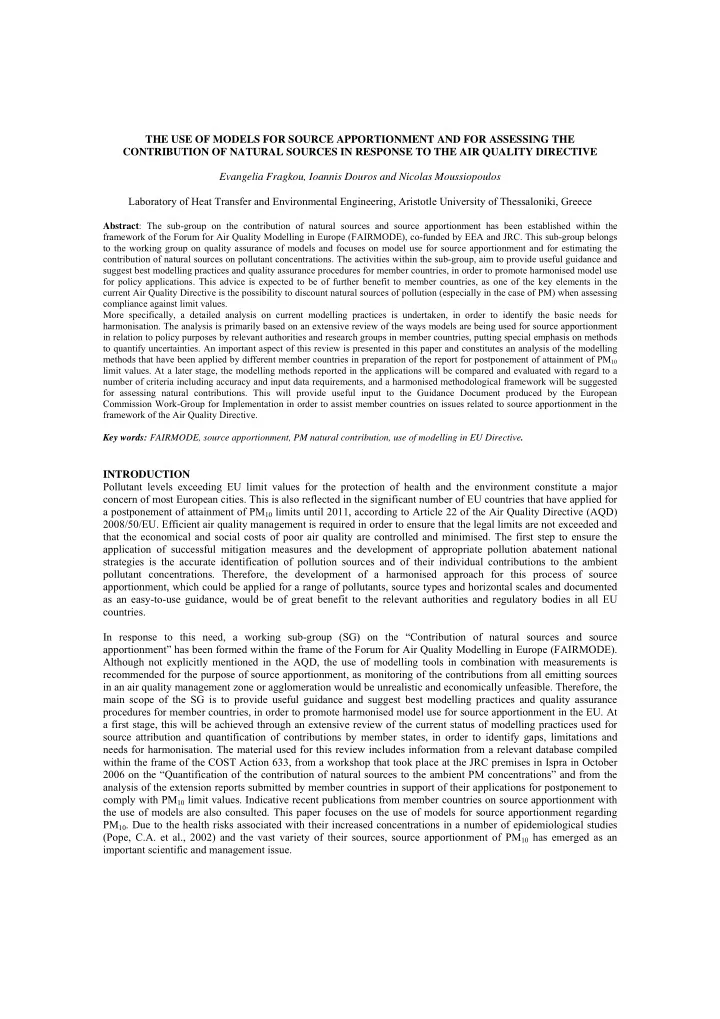

THE USE OF MODELS FOR SOURCE APPORTIONMENT AND FOR ASSESSING THE CONTRIBUTION OF NATURAL SOURCES IN RESPONSE TO THE AIR QUALITY DIRECTIVE Evangelia Fragkou, Ioannis Douros and Nicolas Moussiopoulos Laboratory of Heat Transfer and Environmental Engineering, Aristotle University of Thessaloniki, Greece Abstract : The sub-group on the contribution of natural sources and source apportionment has been established within the framework of the Forum for Air Quality Modelling in Europe (FAIRMODE), co-funded by EEA and JRC. This sub-group belongs to the working group on quality assurance of models and focuses on model use for source apportionment and for estimating the contribution of natural sources on pollutant concentrations. The activities within the sub-group, aim to provide useful guidance and suggest best modelling practices and quality assurance procedures for member countries, in order to promote harmonised model use for policy applications. This advice is expected to be of further benefit to member countries, as one of the key elements in the current Air Quality Directive is the possibility to discount natural sources of pollution (especially in the case of PM) when assessing compliance against limit values. More specifically, a detailed analysis on current modelling practices is undertaken, in order to identify the basic needs for harmonisation. The analysis is primarily based on an extensive review of the ways models are being used for source apportionment in relation to policy purposes by relevant authorities and research groups in member countries, putting special emphasis on methods to quantify uncertainties. An important aspect of this review is presented in this paper and constitutes an analysis of the modelling methods that have been applied by different member countries in preparation of the report for postponement of attainment of PM 10 limit values. At a later stage, the modelling methods reported in the applications will be compared and evaluated with regard to a number of criteria including accuracy and input data requirements, and a harmonised methodological framework will be suggested for assessing natural contributions. This will provide useful input to the Guidance Document produced by the European Commission Work-Group for Implementation in order to assist member countries on issues related to source apportionment in the framework of the Air Quality Directive. Key words: FAIRMODE, source apportionment, PM natural contribution, use of modelling in EU Directive . INTRODUCTION Pollutant levels exceeding EU limit values for the protection of health and the environment constitute a major concern of most European cities. This is also reflected in the significant number of EU countries that have applied for a postponement of attainment of PM 10 limits until 2011, according to Article 22 of the Air Quality Directive (AQD) 2008/50/EU. Efficient air quality management is required in order to ensure that the legal limits are not exceeded and that the economical and social costs of poor air quality are controlled and minimised. The first step to ensure the application of successful mitigation measures and the development of appropriate pollution abatement national strategies is the accurate identification of pollution sources and of their individual contributions to the ambient pollutant concentrations. Therefore, the development of a harmonised approach for this process of source apportionment, which could be applied for a range of pollutants, source types and horizontal scales and documented as an easy-to-use guidance, would be of great benefit to the relevant authorities and regulatory bodies in all EU countries. In response to this need, a working sub-group (SG) on the “Contribution of natural sources and source apportionment” has been formed within the frame of the Forum for Air Quality Modelling in Europe (FAIRMODE). Although not explicitly mentioned in the AQD, the use of modelling tools in combination with measurements is recommended for the purpose of source apportionment, as monitoring of the contributions from all emitting sources in an air quality management zone or agglomeration would be unrealistic and economically unfeasible. Therefore, the main scope of the SG is to provide useful guidance and suggest best modelling practices and quality assurance procedures for member countries, in order to promote harmonised model use for source apportionment in the EU. At a first stage, this will be achieved through an extensive review of the current status of modelling practices used for source attribution and quantification of contributions by member states, in order to identify gaps, limitations and needs for harmonisation. The material used for this review includes information from a relevant database compiled within the frame of the COST Action 633, from a workshop that took place at the JRC premises in Ispra in October 2006 on the “Quantification of the contribution of natural sources to the ambient PM concentrations” and from the analysis of the extension reports submitted by member countries in support of their applications for postponement to comply with PM 10 limit values. Indicative recent publications from member countries on source apportionment with the use of models are also consulted. This paper focuses on the use of models for source apportionment regarding PM 10 . Due to the health risks associated with their increased concentrations in a number of epidemiological studies (Pope, C.A. et al., 2002) and the vast variety of their sources, source apportionment of PM 10 has emerged as an important scientific and management issue.
Recommend
More recommend